To Survive a Drought, Fix the Price of Water
Air Date: Week of April 24, 2015
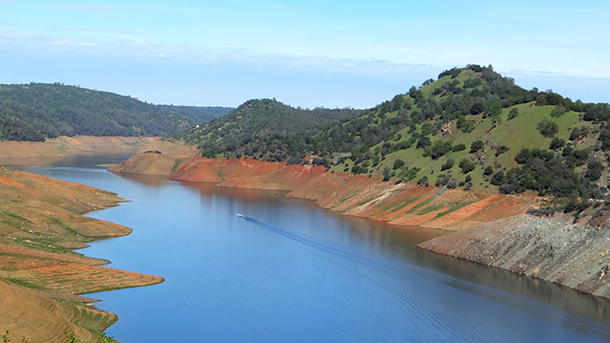
Don Pedro Lake, March 2015 (Photo: Rene Rivers; Flickr CC BY 2.0)
The ongoing drought in California has galvanized Governor Jerry Brown to impose mandatory restrictions on domestic water consumption. Agriculture consumes 80 percent of California’s water each year. As independent writer Mark Hertsgaard explains to host Steve Curwood, even though farm allocations have been cut, many farmers are getting that water for cheap, or unsustainably tapping deep aquifers.
Transcript
CURWOOD: From the Jennifer and Ted Stanley Studios in Boston and PRI, this is Living on Earth. I’m Steve Curwood. The California drought is expected to get even worse this summer, with more wildfires and tighter water restrictions ahead. Governor Jerry Brown has already imposed water cuts of 25 percent for business and residential use across the state. And last year, surface water for agriculture was cut back by an average of 25 percent, forcing as many as 400,000 acres to remain fallow. The long running drought threatens California’s water-hungry agriculture, which grows as much as half of the fresh produce consumed in the US, as well as billons of dollars worth of milk, nuts and wine grapes. Mark Hertsgaard has been looking at the California water crisis. He’s an independent journalist, and author of the book "Hot: Living Through the Next 50 Years on Earth".
HERTSGAARD: We're entering the fourth year of the drought and the scientists are saying that this could be the worst drought in this part of the world in 1,200 years. There is no sign that the drought is letting up, and of course it's important to remember here that the geological record tells us that this region of what we now call California has many times over the past thousand years had droughts that last even ten and sometimes as much as 20 to 30 years. So as hard as it is to believe, we could just be at the start of this drought.
CURWOOD: So, Mark what you think about Jerry Brown's recent water restrictions in California? I believe they're unprecedented.
HERTSGAARD: They are unprecedented. It's the first time in history that any California governor has ordered rather than requested restrictions. But, of course Governor Brown has been criticized for the nature of these restrictions. He has imposed restrictions - pretty big ones - on the residential users and he's required that they restrict their water used by 25 percent this year. At the same time, though, the governor’s executive order said to the agricultural sector that it must only submit "plans" for future drought and that's a problem because agriculture is responsible for 80 percent - that's eight zero percent - of all the water that's used here in California. So the criticism has been, "Well, how can you hope to solve the problem if you're leaving 80 percent of the problem off the table?" And agriculture is important but it's only 2 percent of California's economy and when you've got two percent of your economy that is using 80 percent of the water, I don't think that's going to be sustainable.
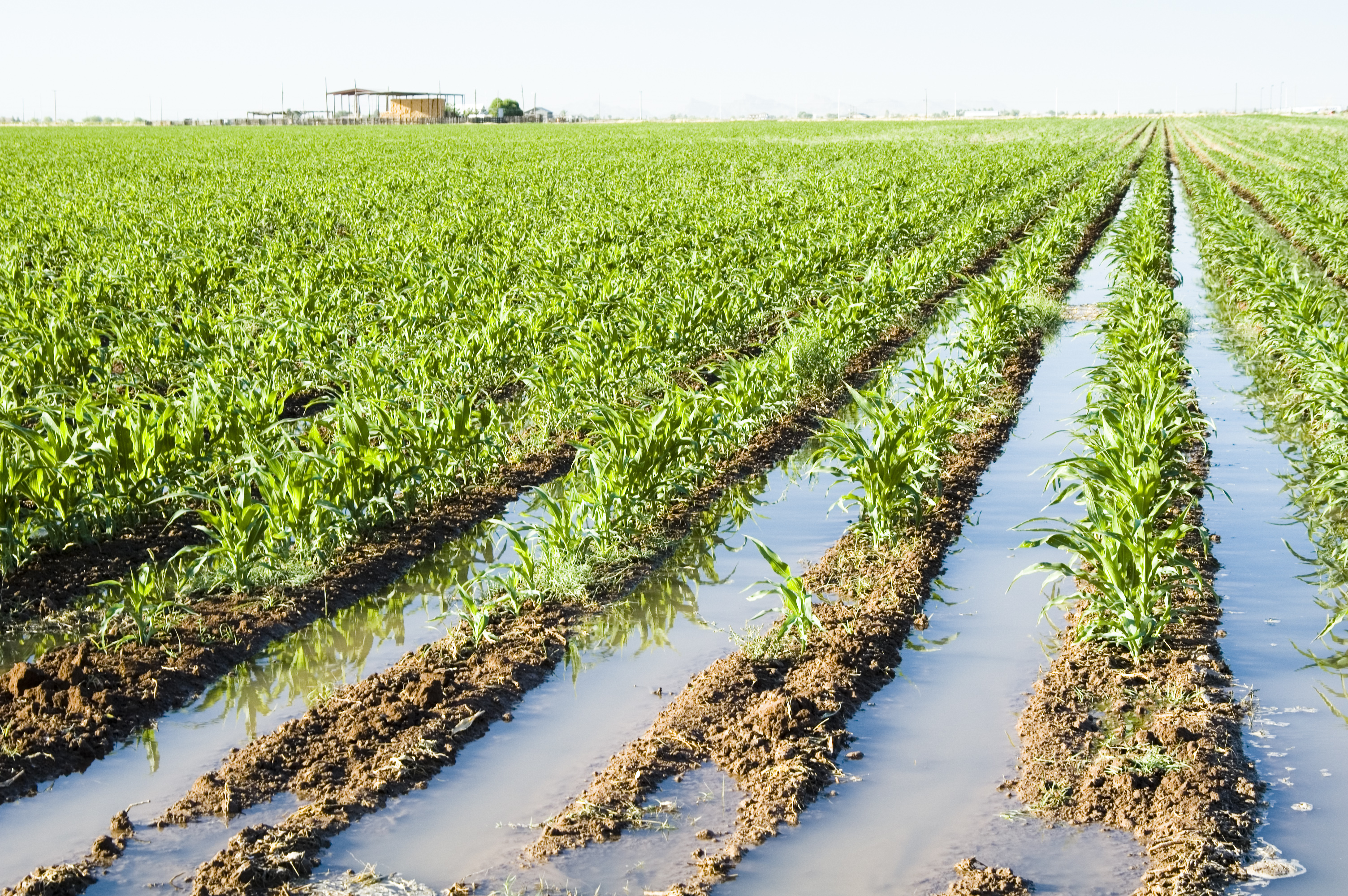
Agriculture is responsible for 80% of California’s water-use, much of it in irrigation. (Photo: Bigstockphoto)
CURWOOD: Now, the residential side is for watering lawns, a lot of it washing cars, only a small amount is consumed as drinking water. On the agricultural side, isn't the formula that food equals water or water equals food? If those guys don't get water they won't be able to produce food.
HERTSGAARD: Well, you would think that, but I found when I dug a little deeper into this in reporting on it that there's no one story out there in the agricultural sector in the Central Valley and, in fact, some of the biggest farmers are literally laughing all the way to the bank, or the quote that I had my story from the pistachio farmer named John Dean said, "I'm smiling all the way to the bank," because these farmers of pistachios and almonds, walnuts, which are pretty thirsty crops, they are reaping record profits, and it's not just because the prices are high this year. It's also because they are literally expanding their acreage in these thirsty crops over recent years. So the big farmers who are able to get ahold of water, they are making money hand over fist even as many of the farmworkers out in the central valley are dearly, dearly suffering. There are communities now, Steve, in the Central Valley where their household faucets no longer give water just mud. So it's a real different picture depending on basically how well politically connected and financially set you are in the Central Valley as to whether agriculture is doing well or not during this drought.
CURWOOD: I know to get the details will take a lot of time here, Mark, but, in brief, how is water priced for agriculture? I understand there are many different ways that give some folks huge advantages and other folks really at a disadvantage.
HERTSGAARD: The water pricing system in California really could fill an entire book. The experts all say that that is though the core of the problem. All the water experts that I interviewed for this story said that look, we have to face the fact that water is unrealistically priced in California it is still inexpensive and therefore we are using more then we should and wasting a lot of it. You can draw an analogy to gasoline prices. When gasoline was a buck 50 a gallon, there were a lot of Americans driving SUVs and other gas guzzling vehicles but when gasoline goes up to $3 or $4 a gallon, suddenly that Prius starts to look pretty good, and you trade in the SUV for the Prius, and that's kind what's going on in California on water now. We still we have a water system for pricing and incentives that is based in the 19th or 20th century and we need to prepare for the 21st century, and one example of that is that there is no single price for water that all farmers pay in California. It depends on how long you had your water rights, what you're doing with them and even what time of year you get the water. So some farmers could be paying as little as $10 an acre-foot and just so you know an acre-foot is about how much water it would take to cover a football field with one foot of water. And other farmers could be paying hundreds of dollars an acre-foot and then it also depends the other big categories: are you getting out water from under the earth or from the state and the federal water projects?
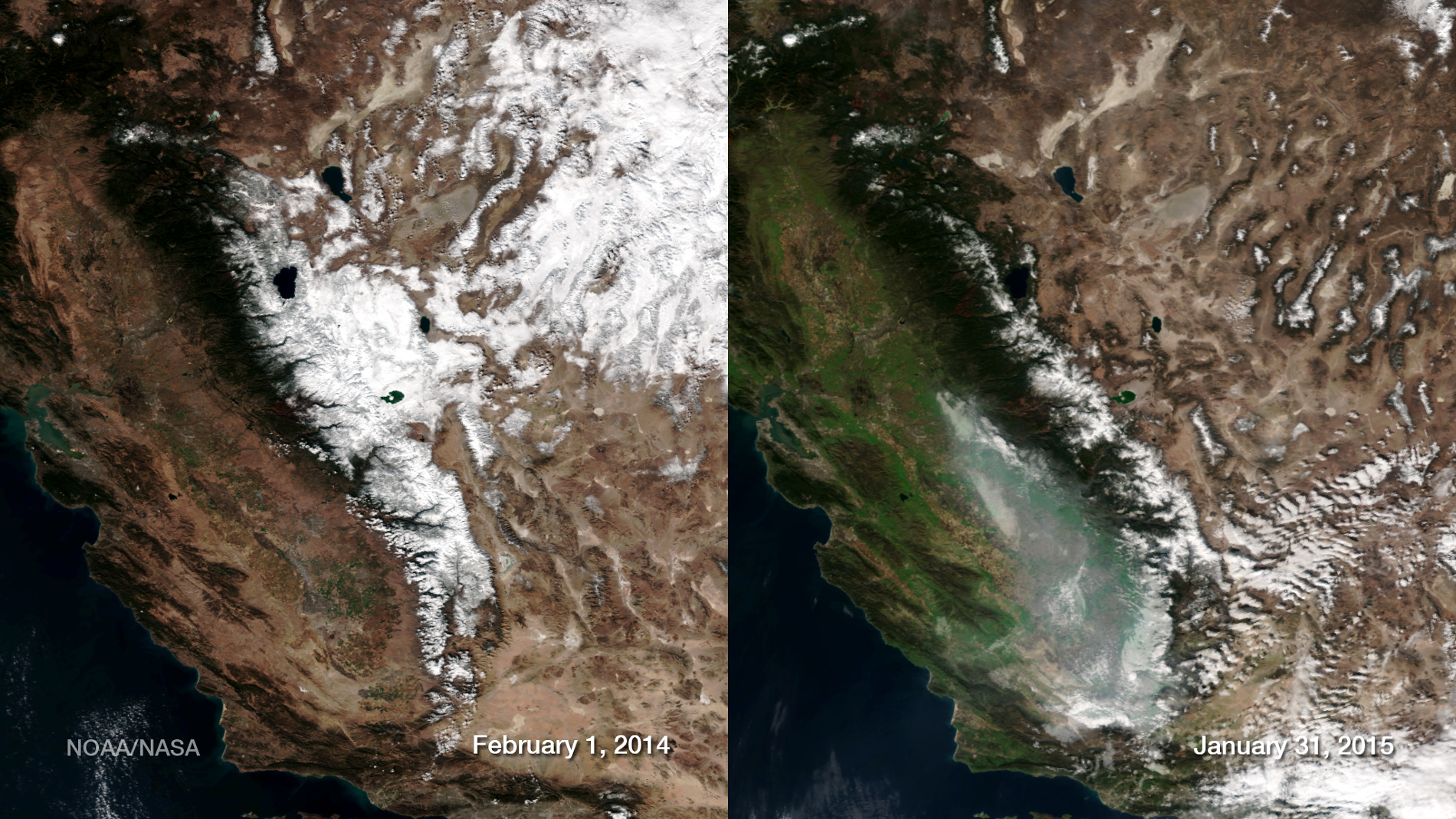
The decline in the snowpack from 2014 to 2015 means that California can expect the drought to continue into this year. (Photo: NOAA satellites)
Governor Brown points out that to his critics that, "Hey, agriculture is already cut back. The state water project is cutting farmers back to 20 percent of their normal allocation in 2015, the feds have cut it back to zero”. And that sounds impressive but it is not stopping the big farmers in the central valley because what they do instead is simply drill deeper wells. And I've been down there in the Central Valley on reporting trips and essentially you've got a kind of an agricultural arms race where farmers are drilling deeper and deeper and deeper wells in order to keep that groundwater coming. And let it be known, the groundwater, they pay nothing for that groundwater. Of course, they do pay for the drilling but the groundwater is free to whoever can take it.
CURWOOD: Tell me more about this use of groundwater, these wells. I take it then that the bigger richer farmers are able to dig deeper, but there must be some limit, some point that aquifer down there is...well, that too will run out of water won't it?
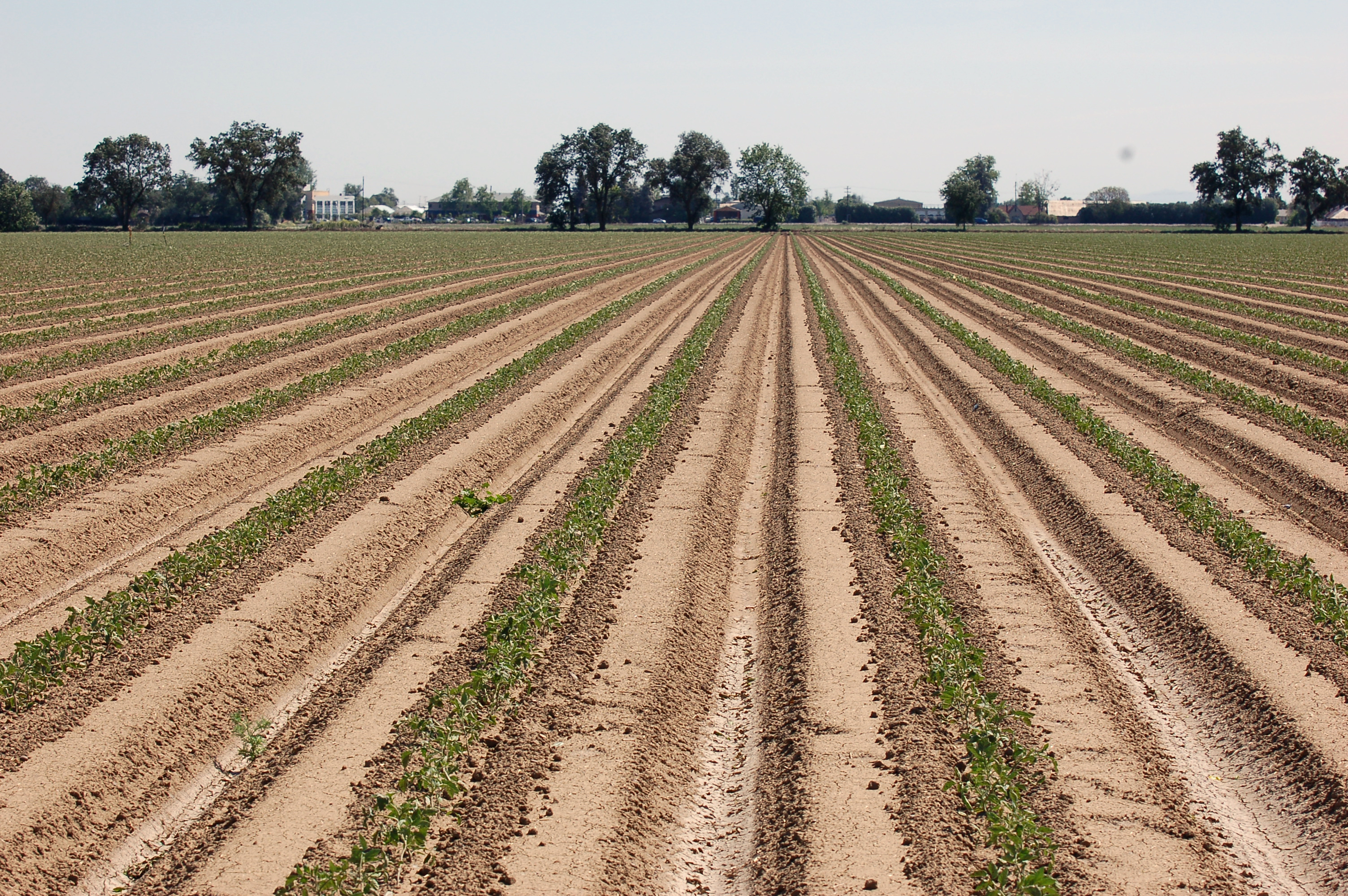
Some farmers are reducing their water consumption by using drip irrigation systems like the one used on this California tomato farm. (Photo: USDA)
HERTSGAARD: I think the groundwater aspect of California's drought is really the big question here, along with pricing. And for many, many years California was the only state in the arid western part of United States to put no limits on groundwater extraction. Zero. Now that changed last fall when the legislature passed a bill the Governor Brown has signed that we'll begin to bring some order to groundwater extractions. At least now we will begin to know how much is being extracted and over time the legislation requires to the extractions to be brought to a sustainable level, but that's not until 2040. Again, some of this criticism comes from the NASA scientist J. Famiglietti who pointed out in the LA Times about a month ago that California only has one year of stored water left, non-groundwater supplies, and we're presumably going to be using that up this year as the drought continues and so what that means is that the big farmers are going to be turning more and more to the groundwater, and that is dangerous not just because our kids are going to need that groundwater to deal with future droughts. The real danger, and this is kind of the doomsday scenario Steve, is that if you extract too much water too fast from a aquifer from under the ground you run the risk of ruining it forever, and if you think it just like drinking water out with a straw if you are you suck up too much of it too fast what happens is that the ground compresses around it, and the danger is that if all of that earth that surrounds the underground water supply compresses, you can essentially collapse the aquifer and render it permanently inaccessible. That would be a nightmare for California, it would be very hard to imagine how significant numbers of people could live in the state going forward if we ruin our groundwater supplies like that, which is why that really has got to be priority number one.
CURWOOD: Now the way forward obviously is conservation. How are the farmers doing along those lines? They put food on the plate to millions of Americans, but, you know, the sophisticated water sparing technologies are a lot of dough and I imagine that's a fair amount of capital expense for farmers to go to drip irrigation and such like that. How are they coping and how is the state prepared to help them cope?
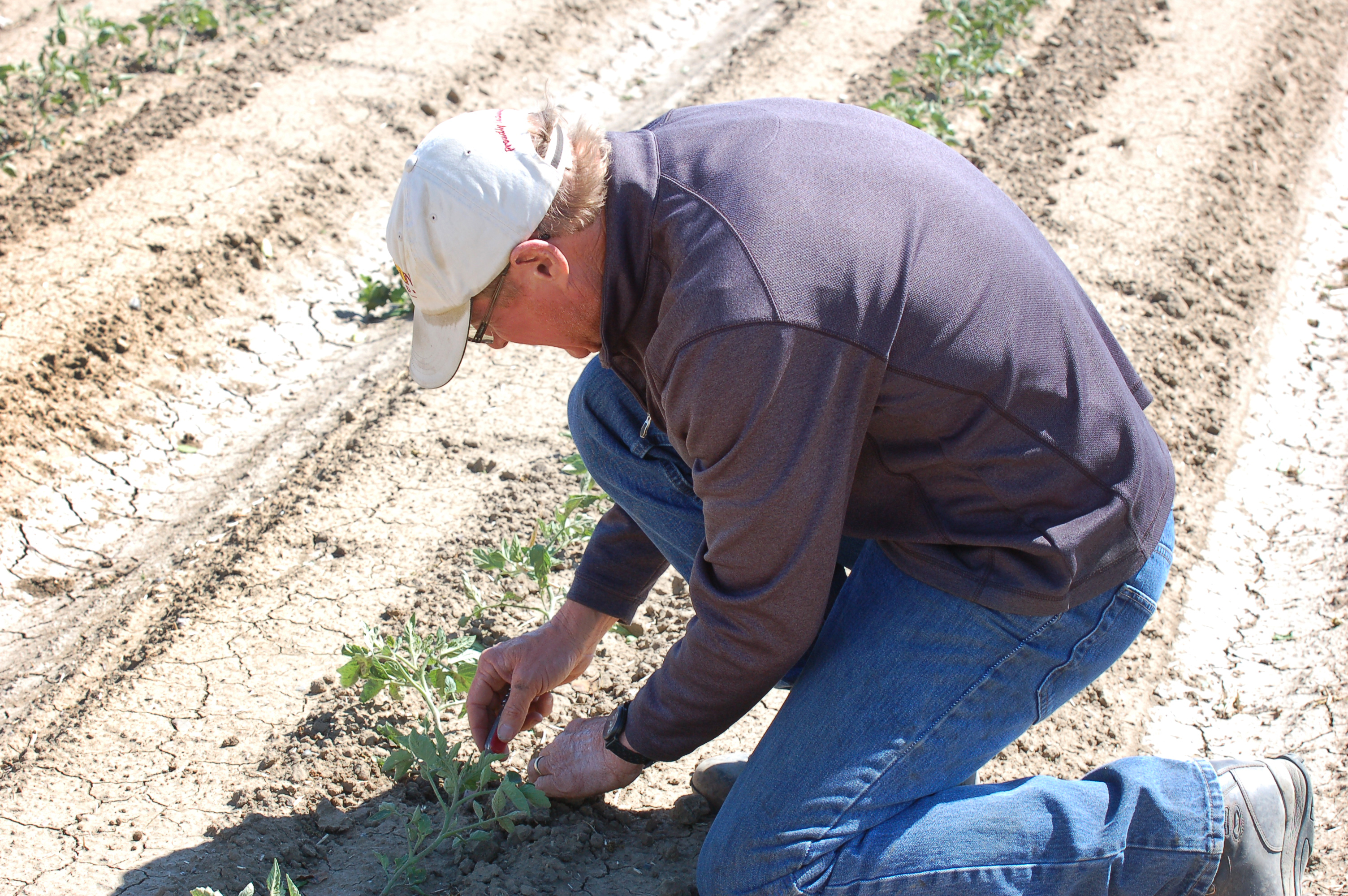
Joe Muller and Sons, Co-Owner Tom Muller checks the condition of his healthy crop of tomatoes that receive underground micro irrigation, in Woodland, CA. (Photo: USDA)
HERTSGAARD: It's interesting; you know, California has been environmental pioneer for a long time, and just like California led the way with energy efficiency, it is beginning to move on water efficiency, and you're right that is clearly the way forward. A new study by the Pacific Institute in Oakland, California, they found that by using just the currently available technologies for improving water efficiency - essentially smarter irrigation, including both drip irrigation and micro spray irrigation instead of flooding the entire field and even the timing of irrigation - that if you use all these we could reduce the agricultural water use in the state by 22 percent. That would mean, had we done that, had we had all those efficiencies in place last year in 2014, the agricultural sector would have had no scarcity of water. The drought's effects would've been basically removed. So there is a lot we can do with efficiency, and in fairness to farmers and to the Brown administration, they say look we're already moving in that direction. And that's true. About half of the farmers in California already use some form of water efficiencies, but there are still the other half who are not, and if you drive through the Central Valley, you'll pass many, many, many acres of almond trees, and you will often see entire fields flooded rather than the kind of micro irrigation. So, there's still a lot of water that is being wasted and that has to be improved. The Brown Administration has rhetorically backed water efficiency and has put a small amount of money where its mouth is. About $20 million has been allocated between last year's budget and this year's budget for the drought to help farmers move in this direction but again that's not going to happen if you don't change the pricing. These big farmers in the Central Valley they know perfectly well that water efficiency saves them money. They're not doing it simply because right now it's cheaper and more profitable for them to waste the water, and so that's really the challenge here. And I think it's a big challenge for Governor Brown as he goes into his final years as governor - and he's a guy who thinks very much about his legacy - can he finally bring some sense to the water system here and prepare California's water system for the 21st century, which as the governor always says the biggest challenge to California in the future is going to be climate change.
CURWOOD: What about Brown's record suggests that he's going to be able to manage this well?
HERTSGAARD: I think that Jerry Brown's history as governor actually points to the most likely solution here. Part of the reason that California is such an environmental pioneer is that Jerry Brown when he was governor the first time in the 1970s pushed through a radical reform of our electricity markets, and in brief he said that we're, from now on, we're going to reward electric utility companies for saving electricity, not for producing more of it. And so, in the '70s they flipped the incentives. As a result California today, 40 years later, we use roughly the same amount of electricity even though our population has doubled since then and economy has tripled in size since then. I think that that is kind of the secret solution if you will to the water crisis. We know that we could use a lot less water if we simply valued efficiency over output, and so what that means is resolving the issues over water rights and the incentive structure and pricing of course. The price has to be higher and the incentive structures have to be sensible.
CURWOOD: Now what about the mix of agricultural products? There are some water-intensive things ranging from almonds to alfalfa, what thought is Governor Brown his crew giving to encouraging the Ag. sector to shift into more water-efficient crops, stuff that grows better in deserts?

Writer Mark Hertzgaard (Photo: Francesca Vietor)
HERTSGAARD: Governor Brown has said explicitly on the record he does not want to tell farmers which crops to plant and not plant. And I must say that most of the water experts that I've interviewed also shy away from that. Again they say, look, let's get the pricing right. If we get the pricing right, then let the marketplace decide what they want to do. If we charge a realistic price for water, that is going to inevitably increase the price of thirsty crops like almonds like alfalfa. Now at that point, leave it up to the market. If the farmers still want to take that chance and if consumers still want to buy almonds if they're suddenly costing $20 a pound rather than $12 a pound, so be it. But most people think that that's a better way to go than getting down into the weeds and trying to tell this farmer and that farmer, plant this don't plant that. It would be a bureaucratic nightmare and I think frankly you get a lot of people complaining about the Big Brotherism. Farmers in particular - you know I grew up on a farm - so this is not about demonizing farmers or demonizing a particular crop. Farmers are pretty bright but you've got to have the incentives right if you want the final results to be true to what's good for everybody in the state.
CURWOOD: Mark Hertsgaard's book is called "Hot: Living Through the Next 50 Years on Earth". Thanks so much for taking the time with us today, Mark.
HERTSGAARD: My pleasure, Steve.
CURWOOD:This story continues to develop, and after we recorded this interview California’s water resources control board began sending letters to about 1500 central valley farmers ordering them to stop taking water from rivers and streams for irrigation.
Links
Mark Hertsgaard’s story on California’s water pricing in the Daily Beast
Living on Earth wants to hear from you!
Living on Earth
62 Calef Highway, Suite 212
Lee, NH 03861
Telephone: 617-287-4121
E-mail: comments@loe.org
Newsletter [Click here]
Donate to Living on Earth!
Living on Earth is an independent media program and relies entirely on contributions from listeners and institutions supporting public service. Please donate now to preserve an independent environmental voice.
NewsletterLiving on Earth offers a weekly delivery of the show's rundown to your mailbox. Sign up for our newsletter today!
 Sailors For The Sea: Be the change you want to sea.
Sailors For The Sea: Be the change you want to sea.
 The Grantham Foundation for the Protection of the Environment: Committed to protecting and improving the health of the global environment.
The Grantham Foundation for the Protection of the Environment: Committed to protecting and improving the health of the global environment.
 Contribute to Living on Earth and receive, as our gift to you, an archival print of one of Mark Seth Lender's extraordinary wildlife photographs. Follow the link to see Mark's current collection of photographs.
Contribute to Living on Earth and receive, as our gift to you, an archival print of one of Mark Seth Lender's extraordinary wildlife photographs. Follow the link to see Mark's current collection of photographs.
 Buy a signed copy of Mark Seth Lender's book Smeagull the Seagull & support Living on Earth
Buy a signed copy of Mark Seth Lender's book Smeagull the Seagull & support Living on Earth

